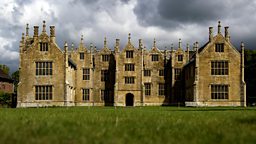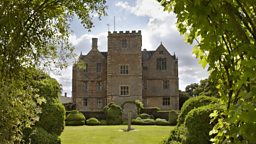Wolf Hall: the locations
Filming for Wolf Hall took place in a wide range of places in the Summer of 2014. Six of these locations were made available for use by the National Trust.
Here, you can find out a bit more about five of these locations and how they were used to represent iconic residences in the six-part series. And better still, they're open to the public.
Montacute House, Somerset

Situated in the south Somerset village of the same name, Montacute House has previously been seen on screen in major films The Libertine and Sense and Sensibility. In Wolf Hall, the Elizabethan mansion represents Greenwich Palace, Henry VIII’s primary London seat and the site of Anne Boleyn’s arrest. Montacute’s extensive grounds provided a spectacular backdrop to jousting sequences and hosted the dazzling Royal Tent.
is open to the public with limited access during the winter and every day from spring through autumn.
Barrington Court, Somerset

This rambling Tudor manor house was saved from ruin and restored by the Lyle family in 1920s, when the court house resembled a barn rather than the proud manor house that it is. Free from collections and furniture, the interiors were dressed for Wolf Hall as York Place, Whitehall, the home of Cromwell’s mentor and friend Cardinal Wolsey.
is open to the public every weekend and every day from spring through autumn.
Lacock Abbey, Wiltshire

Founded early in the 13th century by the Countess of Salisbury as a nunnery of the Augustinian order, Lacock Abbey is a prime site for film and television productions including Cranford, the Harry Potter films and The Other Boleyn Girl. Following the dissolution of the monasteries, Henry VIII sold the abbey to Sir William Sharington, one of his courtiers, who converted it into a house. In the drama the exteriors represent Wolf Hall, the Seymour family seat.
is open to the public year round.
Chastleton House, Oxfordshire

Chastleton House was built by a rich wool merchant, whose descendants later lost their wealth and so could not afford to update the original building. For that reason Chastleton has remained an exceptionally well-preserved time capsule. Chastleton’s small stone courtyard provided the location for the dramatic scenes from Cromwell’s miserable childhood at a blacksmiths in Putney, while interiors represent Wolf Hall, the Seymour family seat and the place where Jane Seymour first catches Henry’s eye.
is open to the public from spring to autumn, and operates with timed tickets as visitor numbers are restricted.
Great Chalfield Manor and Garden, Wiltshire

Great Chalfield Manor is a moated manor built between 1465 and 1480 for Thomas Tropenell, a modest member of the landed gentry who made his fortune as a clothier. It is a very popular location for filming and has been seen in Lark Rise to Candleford, The Other Boleyn Girl, and Tess of the D’Urbervilles. For Wolf Hall its interiors stood in for Austin Friars, Thomas Cromwell’s home, a happy place teeming with in-laws and wards, nieces and nephews and abandoned wives.
is the home of Robert and Patsy Floyd who manage the house, gardens and farm for the National Trust. The house and garden are open to the public from spring through autumn.
All photos provided courtesy of the National Trust and photographers John Millar (Montacute House, Barrington Court), James Dobson (Lacock Abbey), Arnhel de Serra (Chastleton House) and Andrew Butler (Great Chalfield Manor).
The National Trust have created a map featuring every property (including privately owned residences) used as locations in Wolf Hall. .
